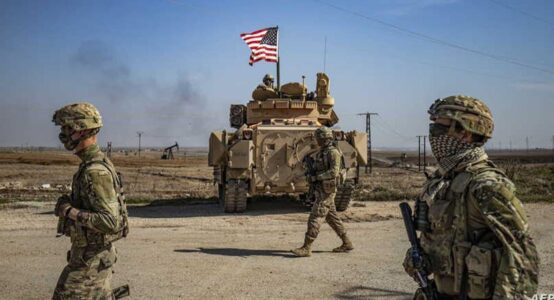
What strikes on Islamic State in iraq really indicate?
The Biden administration conducted airstrikes on Islamic State (ISIS) leaders in Syria on Jul. 12, 2022. This isn’t the first, nor even the second time that ISIS has lost its leader. Yet, the rationale for combating a defeated group with no resources, land, or stable leadership remains unchanged.
Beyond this, the United States has overlooked the dangers of stationing US troops in close proximity to Russian and Iranian troops. Washington should acknowledge that victory has been achieved, and withdraw from Iraq and Syria.
First, we need to dispel the cognitive dissonance. Either ISIS is still a threat or it isn’t. If it is still a threat, then the preceding eight years of strikes have failed as a strategy, and continuing them doesn’t make sense.
If ISIS isn’t a threat, then the continuation of this mission isn’t necessary. In either case, bureaucratic inertia has kept the United States in action despite little rationale to do so.
The US anti-ISIS mission, Operation Inherent Resolve, began under the Obama administration following ISIS’s rapid conquest of northern Iraq and southern Syria.
But that was nearly a decade ago, and ISIS has been cut down by a coalition comprising virtually every actor in the region. The group has lost tens of thousands of fighters, all its territory, and the oil wells, which were its main source of revenue.
The United States is inflating the threat of a ghost. The institutional bias in Washington toward do-somethingism leads policymakers to incorrectly assess that US power can solve terrorism — and that US power is unsubstitutable.
Without a conventional enemy to combat, it makes little sense to keep US boots on the ground in Iraq or Syria. President Joe Biden formalized the US transition to an advise-and-support role last year. This shift means Iraqis are now in the lead in conducting airstrikes, patrolling, clearing sites, and gathering intelligence, while the United States plays a more logistical role.
The larger US role in Iraq and Syria also includes supporting local militias, primarily Kurdish groups, with equipment and training. But this support of militias to achieve US aims in Iraq and Syria mirrors the same mistakes made in Afghanistan.
According to a report by the Special Inspector General for Afghanistan Reconstruction, “[T]he United States helped empower a class of strongmen at the local and national levels who had conflicted allegiances between their own power networks and the Afghan state.”
Keeping troops in the country still accepts risks that outweigh the benefits, and are ill-suited for the long-term role of preventing terrorism. Airpower can’t substitute for state-building and legitimacy, and that’s a problem only the Iraqis can solve. That means it’s time to finish the hand-off to the Iraqis. The United States should withdraw all troops from Iraq and discontinue support for local militias, which undermine the Iraqi government’s control.
The US presence in Iraq and Syria isn’t just a bad value proposition; it’s dangerous because it risks conflict with Russia and Iran. Antagonizing these nations isn’t a display of strength, but it does risk the lives of US troops with little benefit to the United States.
Russia still has a robust presence in Syria and has already had confrontations with the United States over its presence there. Given the US support to Ukraine, putting a few isolated units of US troops directly in range of Russian bombers is a dangerous proposition.
Likewise, Iran has a robust presence in both Syria and Iraq. The US presence hasn’t bolstered deterrence with Iran but rather undermined it by giving Iran’s proxies in Iraq a popular mandate to force a US withdrawal by force. The United States can withdraw from Iraq without risking its security.
By contrast, Iran can’t withdraw from its own region. Its resolve to secure its interests in Iraq is stronger than Washington’s, which is why it’s willing to risk more. In the game of chicken, Iran can’t swerve. Washington can respond to that reality by accepting disaster or by averting the collision.
It’s also contradictory for the United States to feel threatened by Iran’s regional presence while at the same time brazenly gambling on US military superiority to deter Iran.
Threat inflation and the corresponding overreaction make a conflict with Iran more likely. Washington doesn’t bolster deterrence against either Russia or Iran with its presence, but it does increase the probability of a confrontation that endangers US troops.
The common rationale for stationing troops is that ISIS will be a recurring threat, and US troops are needed to periodically “mow the grass.” Such views are espoused both by senior officials at the Department of Defense and by the UN. But we don’t need to mow grass in the Syrian desert.
Fears of an Iraqi collapse mirroring that of Kabul don’t conform to reality. The Afghan government was a house built on sand and held together by American dollars that could buy compliance but not commitment by Afghan soldiers.
Iraqis, particularly the majority Shi’i armed forces, are not willing to accept the return of an extremist death cult just because Washington pulls out.
The real threat then isn’t an ISIS resurgence. Instead, it is stumbling into a conflict with Russia or Iran, which is preventable. The United States loses nothing by withdrawing from Iraq and Syria, either militarily or politically. Maneuvering out of a precarious position isn’t defeatist; it’s smart.
Source: Shafaq News





